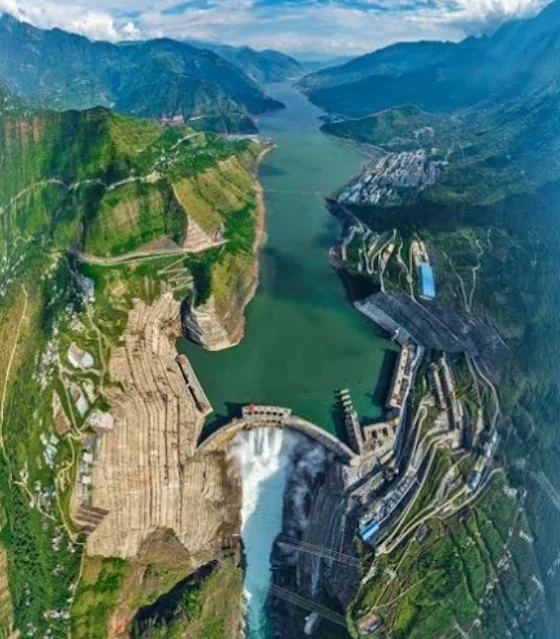Hydropower in China: A Giant at a Crossroads
China stands as the undisputed global leader in hydropower, harnessing the power of flowing water to generate a staggering amount of electricity.
This article delves into the depths of Chinese hydroelectricity, exploring its history, current status, statistics, and future prospects. We'll navigate through the data, analyze the impact, and uncover the challenges and opportunities that lie ahead.
A Historical Perspective:
China's journey with hydropower began in the early 20th century, with the construction of the Shilong Dam in 1912. However, significant growth only emerged in the latter half of the century, fueled by industrialization and the need for reliable energy sources. Since then, China has embarked on an ambitious dam-building spree, culminating in its current position as the world's hydro powerhouse.
Hydropower Capacity in China: A Global Leader
China, with its vast network of rivers and mountainous terrain, is a global leader in hydropower generation. Here's a table summarizing the key aspects of hydropower capacity in China:
| Factor | Description |
|---|---|
| Hydroelectric Potential | China has an estimated hydroelectric potential of around 680,000 megawatts (MW). |
| Installed Capacity | As of 2023, the total installed hydroelectric capacity in China is around 380,000 MW, representing approximately 22% of the country's total installed power capacity. |
| Largest Hydropower Plants | Some of the largest hydroelectric power plants in China include: |
* Three Gorges Dam
* Gezhouba Dam
* Ertan Dam
* Xiluodu Dam
* Baihetan Dam
| Energy Exports | China is a significant exporter of hydropower to neighboring countries, particularly Southeast Asia. | | Challenges | The development of hydropower projects in China faces challenges such as: * Environmental Impacts: Hydropower projects can have significant environmental consequences, including habitat destruction and impacts on aquatic ecosystems. * Social Issues: The construction of dams often displaces communities and can lead to social conflicts. * Economic Dependence: Overreliance on hydropower can make China vulnerable to fluctuations in water availability and energy demand.
Note: The data in this table may vary slightly due to ongoing developments and updates in China's energy sector. For the most accurate and up-to-date information, please refer to official sources from the Chinese government or energy agencies.
The Numbers Tell the Story:
- Installed Capacity: As of 2022, China boasts a colossal installed capacity of 390.9 GW, including 36.4 GW of pumped storage hydro. This dwarfs the capacity of any other nation, nearly double the second-placed Canada.
- Generation: In 2021, China's hydropower plants churned out an impressive 1.3 terawatt hours (TWh) of electricity, accounting for roughly 16% of the nation's total generation. This surpassed Brazil, the historical leader, by a significant margin.
- Regional Distribution: The southwestern provinces, particularly Sichuan and Yunnan, hold the reins of China's hydro potential due to their abundant mountainous terrain and river systems. The Three Gorges Dam, the world's largest hydroelectric facility, resides in this region, contributing significantly to national generation.
- Economic Impact: Hydropower plays a crucial role in China's economic engine, powering industries, stabilizing grids, and providing affordable electricity to millions. It's estimated to have contributed up to 7% of China's GDP growth in recent years.
Beyond the Numbers:
While the statistics paint a picture of immense success, the story of Chinese hydropower is multifaceted. We must consider the environmental and social implications of this large-scale development:
- Environmental Concerns: Dam construction has sparked concerns about ecosystem disruption, biodiversity loss, and displacement of communities. Sedimentation, water quality changes, and impacts on downstream populations are additional environmental considerations.
- Social and Cultural Impacts: Resettlement of communities residing in dam construction zones brings social challenges. Additionally, cultural heritage sites can be submerged or altered, raising concerns about preserving historical identities.
Facing the Future:
China's future with hydropower rests at a crossroads. Balancing the need for clean energy with environmental and social responsibility is paramount. Here are some key points to consider:
- Sustainable Development: China is shifting towards smaller, run-of-the-river projects with less environmental impact. Additionally, investments in fish passage technologies and ecological restoration are being made.
- Technological Advancements: China is exploring advanced hydropower technologies like pumped storage and tidal energy, offering cleaner and more flexible solutions.
- Regional Cooperation: Collaboration with neighboring countries on transboundary river management and hydropower development can foster regional stability and optimize resource utilization.
Data Tables
Table 1: Top 5 Provinces in China by Hydropower Installed Capacity (2022)
| Province | Installed Capacity (GW) | Percentage of National Capacity |
|---|---|---|
| Sichuan | 97.8 | 25.0% |
| Yunnan | 80.6 | 20.6% |
| Hubei | 55.2 | 14.1% |
| Guizhou | 45.2 | 11.6% |
| Zhejiang | 24.5 | 6.3% |
Conclusion:
China's hydroelectricity story is a complex narrative of growth, innovation, and challenges. While its contribution to clean energy and economic development is undeniable, navigating the environmental and social impacts remains crucial. Moving forward, China must embrace sustainable practices, explore advanced technologies, and prioritize regional cooperation to ensure a brighter future for hydropower in the world's most populous nation.
Further Exploration:
For a deeper dive into specific statistics and detailed data, the following resources are recommended:
- International Hydropower Association: https://www.hydropower.org/
- China National Development and Reform Commission: https://en.ndrc.gov.cn/
- World Bank: https://www.worldbank.org/en/country/china


